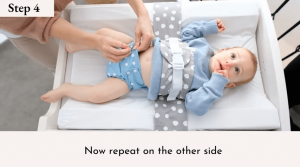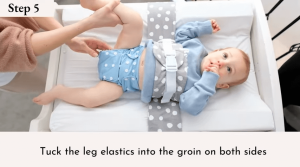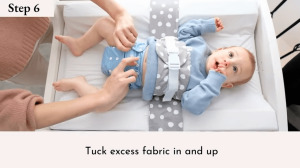If you’re a new parent, changing your baby’s cloth nappy might initially seem intimidating. However, don’t worry; it gets easier with practice, and soon you’ll become a pro at it. This comprehensive guide will walk you through the process, no matter what type of cloth nappy you’re using, whether it’s pre-fold, pocket style, or all-in-one.
How to change a Cloth Diaper-step by step
Follow these simple steps to change your baby’s cloth nappy easily.
What you will need to change a cloth diaper .
- Before you begin, it’s essential to be well-prepared. Here’s what you’ll need:
- A fresh cloth nappy.
- A reusable or disposable nappy liner.
- A container of lukewarm water and a soft washcloth, cotton wool, or fragrance-free baby wipes.
- Barrier cream to shield your baby’s delicate skin from nappy rash.
- A wet bag or nappy bucket to store soiled nappies.
- Depending on the type of nappy you’re using, you might also require:
- Nappy grips or fasteners.
- A clean outer covering.
- An additional absorbent booster.
- Nappy sacks if you’ve opted for disposable liners.
- A soft cloth, towel, or muslin for gently drying your baby’s bottom.
Step 1: Removing the Dirty Nappy and Cleaning Your Baby

- If you’re using a nappy wrap, undo the fastenings and gently fold back the front. Unfasten the soiled nappy and similarly fold back its front section.
- The dirty nappy should be unfastened and folded back.
- If your baby has soiled the nappy, use the front part to wipe off as much as possible.
- When cleaning your baby, gently lift their bottom from the changing surface by holding both ankles. Use the clean side of the nappy to tuck away the soiled one underneath your baby.
- Employ a damp cloth or baby wipe to cleanse your baby’s genital area, ensuring that for girls, you wipe from front to back. Use an additional wipe to clean your baby’s buttocks, making sure to reach all the tiny crevices. Finally, apply a thin layer of barrier cream to safeguard against nappy rash.
Step 2: Putting on the New Cloth Nappy

- Make sure that the upper edge of the fresh nappy is correctly aligned with your baby’s waist. Then, gently pull the front half of the nappy up to your baby’s tummy.
- For newborns, make sure the nappy doesn’t cover the umbilical stump.
- Spread the part of the nappy between your baby’s legs comfortably.
Step -3
- Secure the nappy in place using the built-in strings, snaps, or Velcro tabs, whichever fastening method your nappy is equipped with. Ensure it fits snugly but comfortably around your baby’s waist to prevent leaks or discomfort. Use nappy grips for pre-fold nappies or flat nappies.

Step -4
- Now repeat on the other side.

Step-5
- Tuck the leg elastic into the grain on the both side.

Step-6
- Tuck excess fabric in and up

Clean up
- Dress up your baby and place in a safe area.
- Dispose of any excess waste in the toilet or flushable liners.
- Cover dirty nappies in a nappy bucket or wet bag until you can wash them.
- Keeping your hands clean or using hand sanitizer is important.
See Video
How do I know if my cloth nappy needs changing?
Changing your baby’s cloth nappy can be tricky at first, but you’ll soon get the hang of it.
| Age Range | Recommended Nappy Change Frequency |
|---|---|
| Newborns | Change at every feed |
| 2-3 Months | Change approximately every 3 hours |
| Around 5 Months | Change six times per day |
| 6 Months+ | Change around 4-5 times per day |
| Toddlers | Change every 4-5 hours for optimum comfort |
How often should I change a cloth nappy?
The recommended frequency for changing your baby’s cloth nappy, just like with disposable nappies, is typically every 2 hours. This 2-hour interval is considered an industry standard, especially in childcare facilities, to ensure the baby’s comfort and hygiene. Changing the nappy every 2 hours helps prevent discomfort, maintain dryness, and minimize the risk of skin irritation or nappy rash.
However, it’s important to note that the frequency may vary depending on your baby’s age, as newborns often require more frequent changes, approximately at every feed, while older babies can go longer between nappy changes. Adhering to this schedule helps keep your baby clean, dry, and happy.
Related Article : What is diaper blowout?
How to Cloth Nappy Additional Tips
Changing cloth nappies doesn’t need to be overwhelming, especially with a bit of practice and these helpful tips:
1. Combined Washing Loads
If you’re finding it challenging to run a nappy-only washing load every two days, here’s a solution: on alternate days, run a pre-wash cycle with your soiled nappies. Afterward, add your baby’s clothes or sheets to the primary wash cycle, but avoid adding towels to prevent piling on the nappies.
2. Flip-Top Bins for Odor Control
Instead of using a bucket with a sealed lid, opt for a flip-top bin. These bins allow air circulation, preventing mold growth and reducing unpleasant odors when you open the lid.
3. Position Inserts for Pocket Nappies
Positioning the inserts on the outside of the pocket not only speeds up stuffing pockets but also facilitates swift removal when they become soiled. However, this method is suitable only for natural fibers like bamboo, organic cotton, or hemp. Avoid using micro-fiber inserts directly against the skin.
4. Versatile Inserts for Absorbency
If you’re looking for a fast and effective solution to boost absorbency, consider using trimmed old terry squares, cotton face washers, or even repurposed Ikea tea towels.
5. Washing Every Second Day
Believe it or not, washing your nappies every second day can extend their lifespan.
6. Quick Summer Nappy Combo
For a super-fast summer combo suitable for babies under 12 months, fold a bamboo insert in three and place it inside a PUL cover. This setup is not only quick but also dries fast and provides the absorbency your baby needs.
7. Stock Up on Wet Bags
When using cloth nappies, you can never have enough wet bags. Once you get the hang of changing nappies at home, heading out will be a breeze. Just make sure you have wet bags on hand. Even after your baby outgrows nappies, these bags make great swimming or library bags.
8. Nappy Liners and High-Pressure Hoses
Consider using nappy liners or a high-pressure hose attached to the toilet, like Little Squirt. It makes dealing with solids much more accessible.
10. Prepare Nappies in Advance
Have your nappies folded, stuffed, or snapped into their rise positions next to your change table, ready to go. You don’t want to be caught off guard by a sudden diaper disaster with no nappies prepared.
11. Efficient Fitted Nappies
If you use fitted nappies, have them ready to go. Open the PUL cover and lay the fitted nappy inside with inserts snapped in and folded into place. Fold, don’t snap the wings over, and secure the PUL cover. When it’s time for a nappy change, open the PUL cover, lay your baby down, fasten the fitted wings, and secure the PUL cover. This method saves you the trouble of putting the fitted nappy on first and then adding the PUL cover.
By following these tips, you’ll not only make cloth nappy changes more manageable but also contribute to a more sustainable and eco-friendly diapering routine for your baby. Happy diapering!
Related Article: Why are my pocket diapers leaking.
Why Choose Cloth Diapers?
These are some of the reasons to prefer cloth diapers.
Reason #1: It’s Best for Baby
Cloth diapers are made from soft, natural fabrics that feel gentle on a baby’s sensitive skin, reducing irritation and diaper
Reason #2: You Can Save Big Bucks
Cloth diapers can be reused, saving you much money over time compared to buying disposables.
Reason #3: You Can Be Eco-Friendly
Reusable diapers help reduce waste, making them a better environmental choice.
Reason #4: Despite What You Think, Cloth Is Convenient
Modern cloth diapers are designed for easy use, with features like adjustable snaps and Velcro.
Reason #5: Yes, Cloth Diapering Is Fun for Many Moms
Many parents find cloth diapering rewarding and enjoy choosing from various colors and patterns.
Reason#6: Easy to Use:
Modern cloth diapers are designed with convenience in mind, featuring simple snaps or Velcro closures.
Reason# 7: Organic Cotton for Better Skin
Cloth diapers, especially organic cotton ones, provide better breathability and reduce skin irritation. Organic cotton is grown without harmful chemicals or pesticides, making it a safer choice for your baby’s delicate skin.
Reason #8: Encourages Early Potty Training
Cloth diapers allow babies to feel the wetness against their skin, helping them become more aware of when to go potty. Unlike disposable diapers, which wick away moisture, cloth diapers encourage early potty training by making babies feel discomfort when wet.
How to Change a Diaper On the Go
To change a diaper on the go, keep your diaper bag well-stocked with essentials like wipes, diapers, and a portable changing pad. Consider the most oversized restroom stall, sink vanity, car seat or trunk, or grassy outdoor area if you need a changing station. Reclined strollers and changing rooms can also work in a pinch. Just look for a safe, clean, and private spot where you can keep your baby comfortable.
Tips for Diapering with Cloth Diapers:
- Be ready for pre-change messes, as babies often need cleaning before a diaper goes on.
- Keep a pacifier handy to help soothe your baby during changes.
- Cornstarch-based baby powder is safer than talc but can promote yeast growth, so going powder-free is often best.
- Consider having some disposable diapers for emergencies or travel.
- Try a double-diaper method for extra absorbency, but leave it on only briefly to avoid rashes.
Warnings:
- Check cloth diapers every 30-45 minutes to avoid prolonged dampness.
- Never leave a baby unattended on a changing surface, as even newborns can roll off.
- If you need to step away, take your baby with you or place them safely in their cot.
Keep nappy disposal bags out of your baby’s reach to prevent suffocation hazards.
Always wash your hands after changing your baby’s nappy to maintain hygiene and reduce the risk of illness.
Can you use baby powder and diaper creams?
- The American Academy of Pediatrics advises against using baby powder, whether talc or cornstarch because it can irritate babies’ sensitive skin and may be harmful if inhaled. Diaper creams are only necessary if your baby has frequent rashes or sensitive skin.
- Petroleum jelly or zinc oxide can create a protective barrier with disposable diapers, but some creams are incompatible with cloth diapers, so consult your pediatrician if using cloth diapers. Let the skin dry before applying any ointment, and see a doctor if rashes worsen.
FAQS- How to change cloth nappy
Q-1 How many hours cloth diapers can be used?
It’s generally recommended to change a cloth diaper approximately every two hours. In this way, you can prevent your child’s skin from being exposed to urine for extended periods, reducing the risk of redness and discomfort. The frequency of diaper changes can vary depending on the diaper’s absorbency and your child’s age, but changing every two hours is a good rule of thumb for maintaining your child’s hygiene and comfort.
Q-2 Do you change the whole cloth diaper?
You won’t require an extra cover, but you should take off the complete diaper, detach the insert from the body (wash them separately), and replace it with a fresh cover and insert after your baby So, yes, you change the whole cloth diaper when it’s soiled.
Q-3 Is it OK to not change nappy at night?
It’s advisable to replace your baby’s nappy every 2-3 hours throughout the night, particularly if they’re not utilizing cloth diapers/nappies. Practicing this approach reduces the likelihood of your child experiencing prolonged contact with urine against their skin, thus minimizing the chances of skin irritation and discomfort.
Q-4 Are cloth nappies better at night?
Indeed, cloth nappies can outperform disposable ones at night, especially if your baby urates heavily. It is because you can enhance the nappy’s absorbency using various booster options tailored to your child’s needs. While there might be a bit of trial and error involved, reusable nappies are generally considered better for overnight use.
Q-5 How many cloth nappies per day?
The number of cloth nappies you’ll need per day depends on whether you’re using them part-time or full-time:
- For part-time use (2-3 nappies per day), 8 to 10 cloth nappies should suffice.
- If you’re using cloth nappies full-time during the day (4-6 nappies per day), you’ll need 12 to 18 cloth nappies.
- For full-time use both day and night, consider having 24 to 28 cloth nappies on hand.
The exact number can vary depending on your baby’s needs and your washing routine, but these are general guidelines to help you get started.
Q-6 How long do cloth nappies last?
Cloth nappies typically last for around 400 washes before showing signs of wear and tear.
Q-7 How can you tell if a cloth diaper is dirty?
You can tell if a cloth diaper is dirty by feeling it, as it will feel soft and squishy when clean and warm and hard to the touch when it’s soiled or saturated with liquid. Another way is to simply sneak a quick peek to visually check for any dirt or wetness.
Final words on How to change cloth nappy
Now you will be well aware of How to change a cloth nappy, changing a cloth nappy might seem a bit overwhelming at first, but with practice, it becomes a routine task that ensures your baby’s comfort and well-being. By following the steps mentioned in this guide, you can efficiently change your baby’s cloth nappy while keeping them clean, dry, and protected from nappy rash.
Remember to prepare all the necessary items, handle the dirty nappy with care, and use gentle cleaning techniques. Knowing when to change the nappy is essential for your baby’s comfort, and the recommended frequency is approximately every two hours. These steps, along with the additional tips provided, will help you navigate the world of cloth nappies confidently and successfully. Happy nappy changing!
Sources:
- https://raisingchildren.net.au
- https://www.happiestbaby.com
- https://www.wikihow.life
- https://publications.aap.org
- https://www.nhs.uk
- https://www.vinmec.com
- https://www.adisc.org
- https://www.chla.org
- https://www.pregnancybirthbaby.org.au
- https://assets.publishing.service.gov.uk
- https://www.emerald.com
- www.magonlinelibrary.com
Read our guide for more info on baby diapers .



